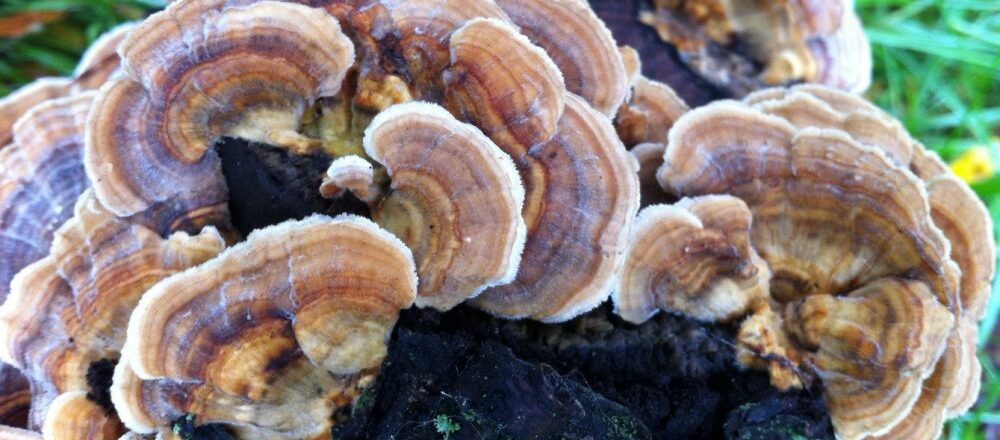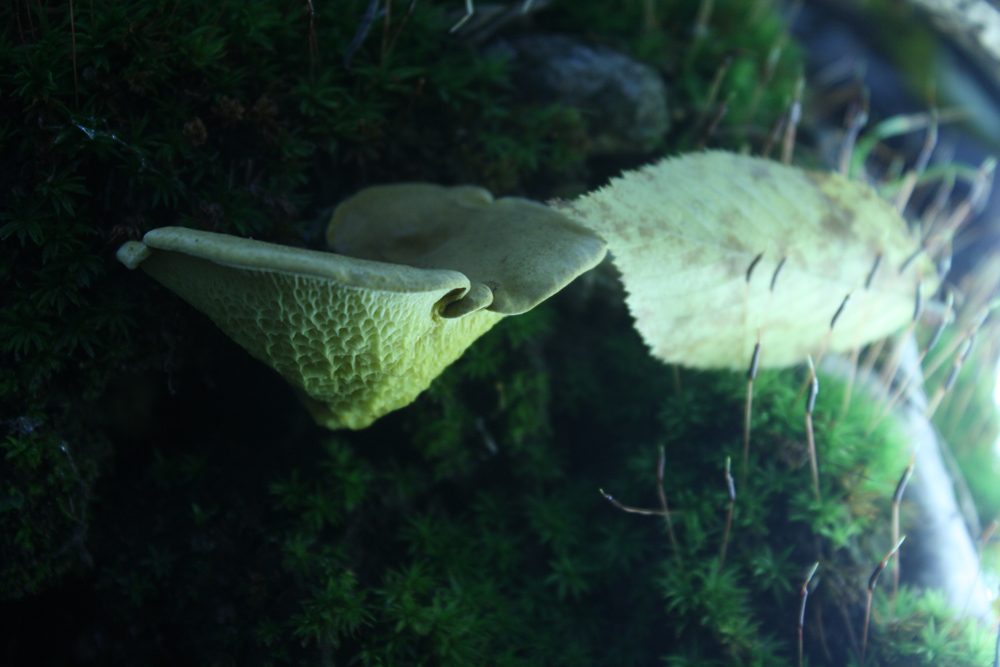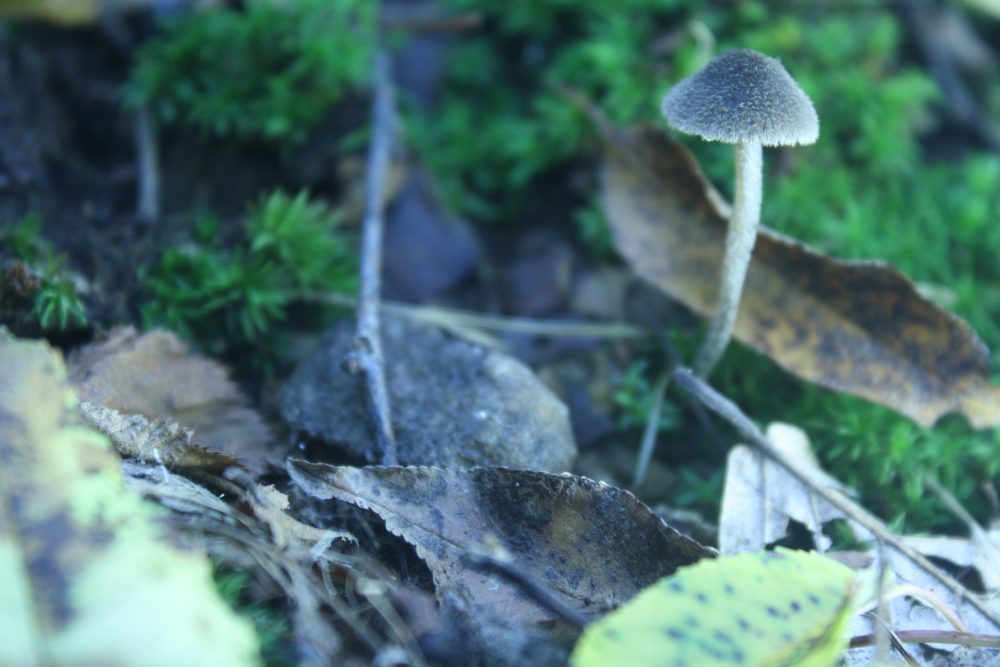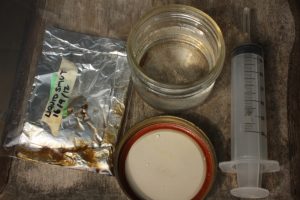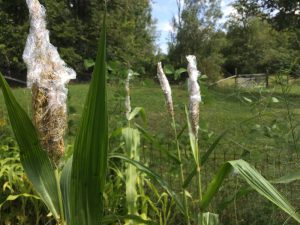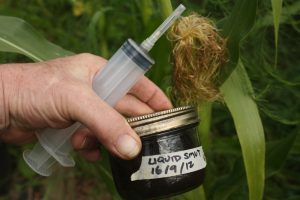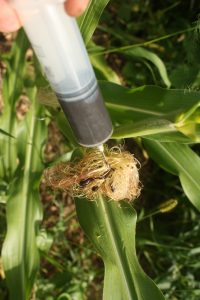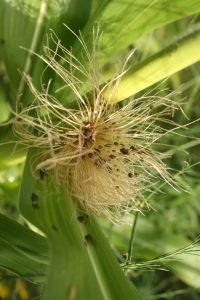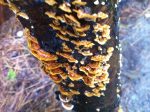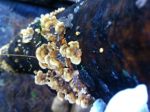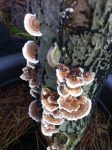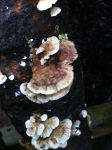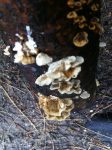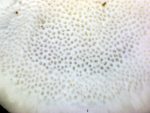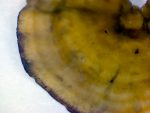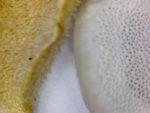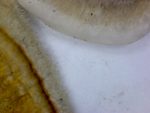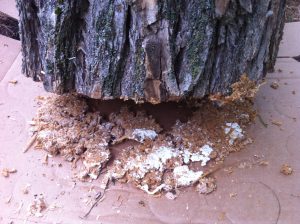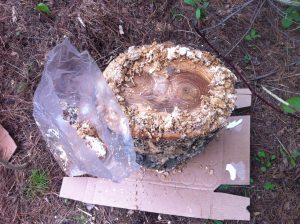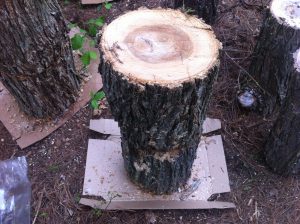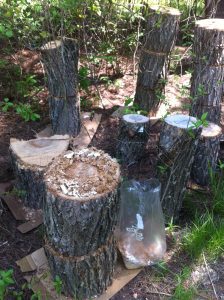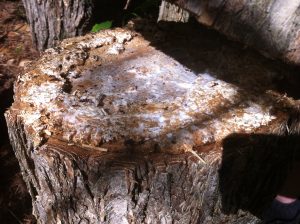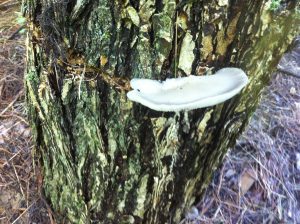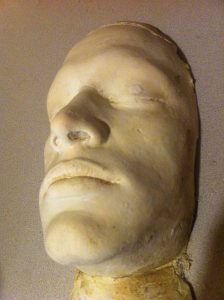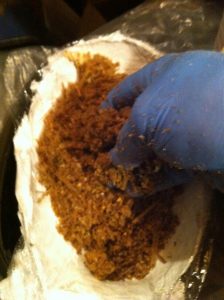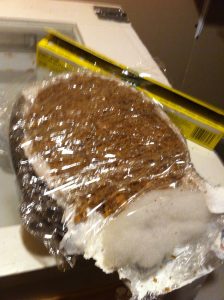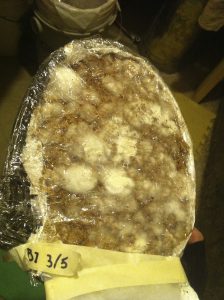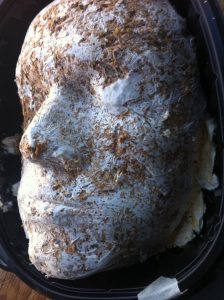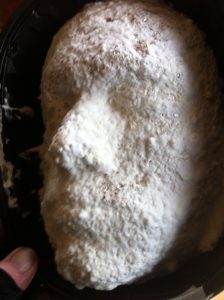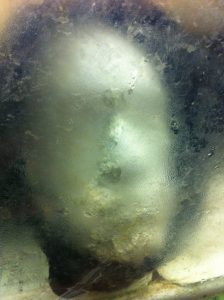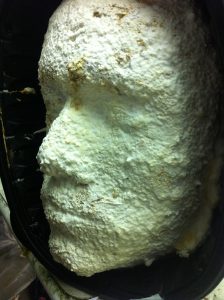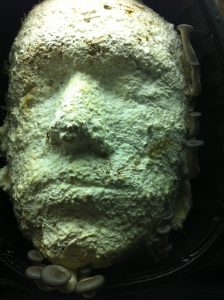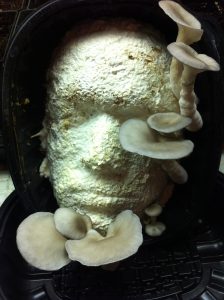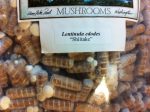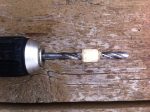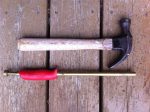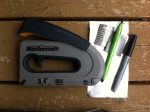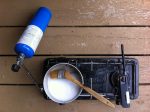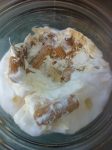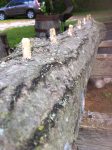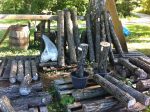The information in this introduction was gleaned from works by M(y)cCoy, Rogers, and Stamets, listed on the MycoResources page. I plan to write individual articles on particular species of interest, as I have already done with Turkey Tail. This article is meant as a general intro to medicinal fungi.
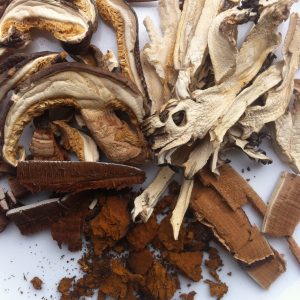 It is often stated that the fungi are more closely related to animals than they are to plants. Their cell walls are made of chitin, like insects and crustaceans, whereas plants cells are made of cellulose and lignin. They consume oxygen and release CO2 just as we do.
It is often stated that the fungi are more closely related to animals than they are to plants. Their cell walls are made of chitin, like insects and crustaceans, whereas plants cells are made of cellulose and lignin. They consume oxygen and release CO2 just as we do.
Where fungi differ from animals is that they are “inside-out”, as it were. While animals are generally self-contained autonomous units which must ingest nutrients to digest them within, fungi grow into their food, extruding digestive enzymes and absorbing the nutrients.
Since fungi in the wild come into direct contact with various microbes, viruses, and other competitive fungi, they have an array of defenses at their disposal. And because, in many ways, their metabolisms are similar to ours, some of these molecules can be used to enhance our health. These powerful substances make up the very structure of the mushroom itself. Of course, as a source of biologically active chemicals, mushrooms create many toxins as well, so it’s important to know the difference. The oft’ quoted maxim applies here: “All fungi are edible, some only once”.
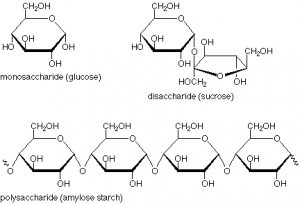 In addition to chitin, mushrooms contain, glucans, mannans, terpenes, and glycoproteins. Polysaccharides combine with proteins to form complex molecules, chains similar to DNA. These compounds have been found to aid the immune system by variously stimulating the growth of disease fighting blood cells, aiding in the detection of pathogens, or modulating the reaction in auto-immune responses, such as inflammation and pain. Terpenes (diterpenes and triterpenes) are aromatic chemicals with medicinal properties of their own which often work synergistically with other compounds, for example facilitating their transport across the blood-brain barrier.
In addition to chitin, mushrooms contain, glucans, mannans, terpenes, and glycoproteins. Polysaccharides combine with proteins to form complex molecules, chains similar to DNA. These compounds have been found to aid the immune system by variously stimulating the growth of disease fighting blood cells, aiding in the detection of pathogens, or modulating the reaction in auto-immune responses, such as inflammation and pain. Terpenes (diterpenes and triterpenes) are aromatic chemicals with medicinal properties of their own which often work synergistically with other compounds, for example facilitating their transport across the blood-brain barrier.![Lentinan is a polysaccharide isolated from the fruit body of shiitake (Lentinula edodes mycelium. Lentinan has been approved as an adjuvant for stomach cancer in Japan since 1985.[1] Lentinan is one of the host-mediated anti-cancer drugs which has been shown to affect host defense immune systems. Lentinan is a polysaccharide isolated from the fruit body of shiitake (Lentinula edodes mycelium. Lentinan has been approved as an adjuvant for stomach cancer in Japan since 1985.[1] Lentinan is one of the host-mediated anti-cancer drugs which has been shown to affect host defense immune systems.](http://www.mycognosis.com/wp-content/uploads/2017/09/Lentinan001-300x175.jpg)
Because chitin is not digestible, medicinal mushrooms must be processed for use. Depending on the species and the intended use, they can be cooked, dried, made into infusions and tinctures, or burnt for their smoke and ash. Many, like Shiitake and Maitake, are valued as delicious gourmet mushrooms. Others like the Birch Polypore and Artists’ conk are bitter and woody-textured. These medicinal compounds are found in both the mycelia and fruiting bodies of the fungi. According to Rogers’ Fungal Pharmacy most edible mushrooms have some medicinal characteristics in addition to their nutritional value.
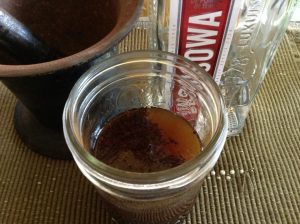 Not all these compounds are water soluble so making a tea might not suffice to extract all the benefits. A common method for extracting medicine from fungi is making a dual extract tincture. In a jar, cover dried broken/powdered mushrooms with 4-5 times their weight in high proof alcohol (30g fungus/120-150g alc.) and soak for at least a month, agitating periodically. After the alcohol soluble constituents have been extracted, press out the solution (I use an Aerobie AeroPress which also makes great coffee) and put the remaining solids (the marc) in a pot with a volume of water equal to the alcohol solution. Weigh the pot and record the weight. Now add 4 times that amount of water and place the pot in boiling water. Simmer the mixture until the liquid is reduced to the original volume (and weight). Press out the liquid and mix the two equal parts together in a dark glass bottle. The alcohol content should be sufficient to preserve the tincture.
Not all these compounds are water soluble so making a tea might not suffice to extract all the benefits. A common method for extracting medicine from fungi is making a dual extract tincture. In a jar, cover dried broken/powdered mushrooms with 4-5 times their weight in high proof alcohol (30g fungus/120-150g alc.) and soak for at least a month, agitating periodically. After the alcohol soluble constituents have been extracted, press out the solution (I use an Aerobie AeroPress which also makes great coffee) and put the remaining solids (the marc) in a pot with a volume of water equal to the alcohol solution. Weigh the pot and record the weight. Now add 4 times that amount of water and place the pot in boiling water. Simmer the mixture until the liquid is reduced to the original volume (and weight). Press out the liquid and mix the two equal parts together in a dark glass bottle. The alcohol content should be sufficient to preserve the tincture.
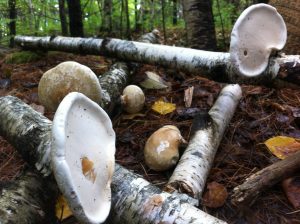 I used to think that powerful natural medicines came from deep in the Amazon jungle or from the far east. I have been pleased to find that many of the most prized medicinal fungi can be found in abundance in our own Boreal forests. In future articles I hope to feature some of these healing mushrooms including Turkey Tail, Birch Polypore, Tinder Conk, Artists’ Conk, Maitake and Chaga.
I used to think that powerful natural medicines came from deep in the Amazon jungle or from the far east. I have been pleased to find that many of the most prized medicinal fungi can be found in abundance in our own Boreal forests. In future articles I hope to feature some of these healing mushrooms including Turkey Tail, Birch Polypore, Tinder Conk, Artists’ Conk, Maitake and Chaga.
Part 1 of this experiment was last year, and that entailed harvesting the spores of a Huitlacoche inhabited corn cob.
In Part 2 I retrieve the liquefied corn smut from the freezer, dilute it in water, and inoculate the silk of my corn plants. I have wrapped the male flowers in plastic film to prevent pollination, which is said to impede the growth of the mycelium. I will post the results hopefully in a couple of weeks. This research says 16 or 17 days: Production and Marketing of Huitlacoche
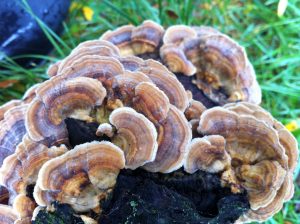 A lot of research has been done, and much written, about the benefits of Trametes versicolor, AKA Turkey Tail. There are many of reports of traditional use, as well as modern scientific studies reporting it contains anticancer, and immune boosting, polysaccharides.
A lot of research has been done, and much written, about the benefits of Trametes versicolor, AKA Turkey Tail. There are many of reports of traditional use, as well as modern scientific studies reporting it contains anticancer, and immune boosting, polysaccharides.
According to Robert Rogers’ The Fungal Pharmacy its Medicinal Properties include antibacterial, anti-inflammatory, antioxidant, anti-tumor, antiviral, cardiovascular tonic, cholesterol modulator, immune tonic, kidney tonic, liver tonic. Anticancer Activity for breast, cervical, esophagus, gastric, leukemia, liver, lung, lymphoma, melanoma, rectal/colon and skin. Antiviral Activity against HIV and Antimicrobial Activity against Aspergillus spp, Candida albicans, Escherichia coli, and Plasmodium spp
Famously, Paul Stamets has claimed his mother was cured of cancer using Turkey Tail, and it has been approved by the FDA for that purpose. It can be chewed whole, eaten ground, or made into a tea, or a tincture.
Turkey Tail is a very common fungus. It is a wood decomposing bracket that grows on almost any kind of dead wood. It is zonate, meaning it has separate concentric color zones, and they come in a range of colors from brown to red. Two different samples can look quite different.
To complicate things there are some look-alikes. Trichaptum abietinum and Stereum hirsutum for example. A friend asked for help identifying a specimen and after a bit of research I realized I had a log with all three on it, which I had assumed were all Turkey Tail. I didn’t see any mention of these fungi being poisonous, but neither are they medicinal or nutritious, so how do we avoid them?
While they look similar on top, they are different below.
- Stereum hirsutum (false turkey tail) top
- Stereum hirsutum (false turkey tail) bottom
- Trametes versicolor (turkey tail) foreground and Stereum hirsutum (false turkey tial) bottom
- Trametes versicolor (turkey tail) top
- Trichaptum abietinum top
- Trichaptum abietinum bottom
The true Turkey Tail is white underneath an has pores in the surface, visible to the naked eye (or with glasses in my case) The False Turkey Tail (Stereum hirsutum ) is yellow and, as a “crust fungus”, it is smooth. The Trichaptum abietinum looks like a faded Turkey Tail and has a toothy surface underneath.
Under the microscope at 20X the differences are more clear.
- Trametes versicolor (turkey tail) bottom
- Stereum hirsutum (false turkey tail) bottom
- Trichaptum abietinum bottom
- Trametes versicolor (turkey tail) vs Trichaptum abietinum bottom
- Stereum hirsutum (false turkey tail) top
- Trametes versicolor (turkey tail) vs Trichaptum abietinum top
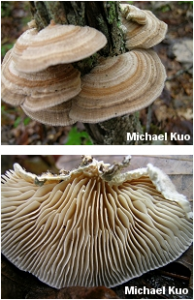
I don’t have a specimen, but there is a third look-alike, Lenzites betulina , which is distinguished from all of the above by having gills. Picture of Lenzites betulina by Michael Kuo
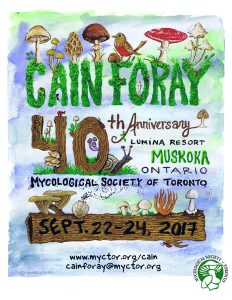 Friday September 22nd to Sunday September 24th
Friday September 22nd to Sunday September 24th
Lumina Resort Muskoka
Not a member of the MST?
The Cain Foray is open to the general public too, and your Cain Foray registration fee gets you a one-year complimentary family membership!
This year’s foray marks the 40th anniversary of the first Cain Foray. The Cain Foray is our annual weekend of mushrooming in the wilderness. In 2017 it will be held at a new venue, the Lumina Resort, which is ideally suited for such an adventure, located away from urban “civilization” east of Huntsville in the District of Muskoka. The Lumina Resort offers an excellent selection of accommodations of one- to four-bedroom chalet cottages and rooms in the main lodge. The resort is surrounded by woods with walking trails that are suitable for collecting mushrooms, and nearby are extensive forests that have more areas for mushrooming. The Leslie Frost Centre is less than a half-hour drive away for those who wish to revisit the trails of the very first Cain Foray.
The Cain Foray starts on Friday night, September 22nd, with a barbecue reception where we can meet our fellow foragers and swap mushroom stories. Saturday morning, after a hearty breakfast, will be spent foraying in groups of about a dozen on various forest trails. After lunch there will be more forays and those who wish may sort and identify the mushrooms that were brought in from the morning forays. We will be guided and helped in this activity by our guest professional mycologists and some keen amateurs, who have both the knowledge and talent to put names to hundreds of diverse mushrooms. Saturday evening will feature an illustrated mushroom talk and all mushrooms that were collected during the day will be displayed. Sunday morning will provide more opportunities to foray or to study the many specimens on display. Our weekend at the Cain ends September 24th after lunch.
Register Now!
Lumina Resort
The Cain Foray will be held at the Lumina Resort east of Huntsville.
Accommodation will be in cottages or main lodge rooms or in 1-4 bedroom chalet cottages with several configurations of living room, fireplace, kitchen or fridge, and bathrooms.
Meals will be taken in the Lumina dining room.
Mycologists and Guest Speaker
Both professional and amateur mycologists will be there to assist in identifying fungi. Guest mycologist this year will be Walter Sturgeon, a well-known Ohio-based mycology enthusiast, co-author of the recently published field guide Mushrooms of the Northeast: A Simple Guide to Common Mushrooms, and author of numerous articles on wild mushroom identification.
Prices
Price per Person
Adult $395
Child 9-13 years $75
Child 8 years and under free
Off-site (no accommodations) $175
Deadline for Registrations: Friday, September 1, 2017
- Cardboard on the forest floor. Covered with Blue Oyster Spawn. A stump is placed on top.
- Sawdust/woodchip spawn is crumbled around the sapwood.
- The second piece of the stump is stacked upon the first, sandwiching the spawn
- Keep on stacking and sandwiching layers of spawn.
- In a few days the mycelium has jumped of the spawn and started to colonize the wood.
- Three weeks later with regular rain and watering, a little flush of one mushroom was a good sign that the spawn is happy.
A Papier Mâché mold lined with plastic film was taken from a plaster original and used to cast mycelia of Blue Oyster Mushrooms (Pleurotus ostreatus) on a medium of wood chips and sawdust. It was then exposed to the appropriate conditions to stimulate fruiting so as to produce mushrooms.
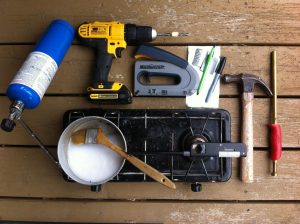 Spring is the season for inoculating logs. Wait until after the last frost to do it so the spawn is not shocked by freezing. You will need Inoculating equipment: Drill w/ 5/16″ bit and 1.25″ stop, staple gun, aluminum labels, ballpoint and Sharpie, Hammer or sawdust spawn injector, portable stove, pot or can to melt wax, natural bristle brush.
Spring is the season for inoculating logs. Wait until after the last frost to do it so the spawn is not shocked by freezing. You will need Inoculating equipment: Drill w/ 5/16″ bit and 1.25″ stop, staple gun, aluminum labels, ballpoint and Sharpie, Hammer or sawdust spawn injector, portable stove, pot or can to melt wax, natural bristle brush.
You will need plug or sawdust spawn and logs or stumps appropriate to the species of mushroom you would like to grow. Oak is good for most species of fungi. See the chart for the preferred type of wood for various popular cultivated mushrooms, although 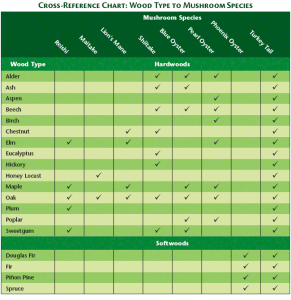 cultivation books and specs from spawn suppliers suggest a a wider variety of woods are acceptable. See recommendations for Shiitake, Maitake and Blue Oyster on the Fungi Perfecti site.
cultivation books and specs from spawn suppliers suggest a a wider variety of woods are acceptable. See recommendations for Shiitake, Maitake and Blue Oyster on the Fungi Perfecti site.
Plug spawn is put in the 5/16″x1.15″ holes with a hammer or mallet. Sawdust spawn is inserted with an injector tool. Holes for sawdust spwn can be bigger and should match the barrel of the tool.
Wax is used to seal the ends of the logs (immediately after cutting), and the holes after the spawn is inserted. This serves to preserve moisture and keep out competing fungi.
According to many sources you should use “cheese wax”. if you find this hard to acquire, you can use candle wax. Many cultivators prefer to use Soy Wax as it is from a renewable resource, as opposed to Paraffin which is petroleum derived. For me the most important distinction is between “pillar” and ‘”container” waxes. Pillar wax is intended for casting free-standing candles. It is harder and formulated to shrink ever so slightly and not stick to the mold, so it tends to flake off the log. Container wax is stickier, softer and does not shrink. Wax can be purchased online (last time I got some, Canwax seemed the best deal) or at craft stores like Michael’s.
For answers to frequently asked questions check out the Fungi Perfecti FAQ about log and stump cultivation of mushrooms.
Yesterday we went to see Steven Martyn of the Sacred Gardener giving a talk called “Dancing with Lyme“. Steven is an experienced herbalist who has personally experienced Lyme in the long term. He first acquired it while camping in Florida, and after initially suppressing it with pharmaceutical antibiotics, it resurfaced (or he re-acquired it) about a decade later. With the help of his colleagues who shared their knowledge based on recent advances in the understanding of how the infection works, he is now symptom-free. He does not discount the possibility that the bacteria may still be in his body in its encysted, dormant form.
I will report what I can recall of his account, as he had a lot of useful insights and references. I also added some links of my own. After that I’ll add what I have found in reference to mushrooms which might also help in the prevention and cure of Lyme, because Steven’s expertise in mostly in the area of herbs.
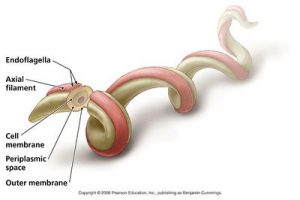 Lyme disease, also known as Lyme borreliosis, is an infectious disease caused by bacteria of the Borrelia type. It is a spirochetal (corkscrew-shaped) bacterium which is extremely fast and capable of drilling itself into tissues to avoid detection by the immune system. It targets inflammation in joints and nerve tissue, taking advantage of existing conditions like candida, arthritis, and congenital predispositions, like nerve problems.
Lyme disease, also known as Lyme borreliosis, is an infectious disease caused by bacteria of the Borrelia type. It is a spirochetal (corkscrew-shaped) bacterium which is extremely fast and capable of drilling itself into tissues to avoid detection by the immune system. It targets inflammation in joints and nerve tissue, taking advantage of existing conditions like candida, arthritis, and congenital predispositions, like nerve problems.
These bacteria are carried between species by black legged, or deer ticks. The nymphs hatch from the eggs uninfected, but can acquire the bacteria from the small rodents on which they pass their first stage of feeding. The tick then lies in wait for a larger animal: a deer, a dog, or you. As the tick begins feeding, the bacteria react to the first blood “analyzing” the immune response and adapting itself to attack or evade, your specific defenses. Individuals with compromised immune systems, whether through emotional or physical stress, genetic predisposition, poor diet, or preexisting infections etc., are more susceptible.
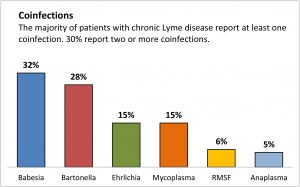 In addition to Lyme, ticks (being the filthy little creatures they are) are usually carrying one or more other bacteria (Babeia, a malaria-like parasite, Bartonella, bacteria that live primarily inside the lining of the blood vessels and more) so that a majority of those infected by Lyme report co-infections of one or more other pathogens. Lyme takes advantage of the inflammations caused by these co-infections. And of course these diseases have there own symptoms.
In addition to Lyme, ticks (being the filthy little creatures they are) are usually carrying one or more other bacteria (Babeia, a malaria-like parasite, Bartonella, bacteria that live primarily inside the lining of the blood vessels and more) so that a majority of those infected by Lyme report co-infections of one or more other pathogens. Lyme takes advantage of the inflammations caused by these co-infections. And of course these diseases have there own symptoms.
It should be noted that Steven and all the experts he cited said that if you have been bitten by a deer tick to immediately go to emergency for treatment with antibiotics. If the course they offer is less, go to your doctor and get it extended to 18-21 days. Unfortunately sometimes the bacteria may survive the treatment and emerge later, in which case further treatment with antibiotics may prove ineffective. The treatments mentioned below can be used in conjunction with conventional medicine, but consult your doctor.
Steven’s main treatment reference is a book by Stephen Harrod Buhner called Healing Lyme. Buhner’s protocol is outlined on his site. Steven also got a lot of help from Stephen O’Neill at the Ontario Lyme disease Clinic and Dr. Maureen McShane.
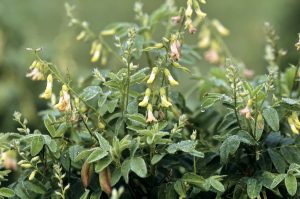 For prevention they recommend Astragalus (available as dried herb, seeds, or young plants from Ritcher’s). Treatments for active Lyme include Teasel, Cat’s Claw, Japanese Knotweed Root (get it from a neighbor who is battling the stuff), Artemisia (Wormwood), Clivers and Andrographis. Buhner recommends drawing out the spirochetes (with teasel tincture), and rebuilding your collagen, before killing them.
For prevention they recommend Astragalus (available as dried herb, seeds, or young plants from Ritcher’s). Treatments for active Lyme include Teasel, Cat’s Claw, Japanese Knotweed Root (get it from a neighbor who is battling the stuff), Artemisia (Wormwood), Clivers and Andrographis. Buhner recommends drawing out the spirochetes (with teasel tincture), and rebuilding your collagen, before killing them.
Buhner has a page recommending herb sources on his site (probably US suppliers), and Steven Martyn recommends Organic Connections, Wainfleet, Herbies Herbs, Toronto, Judy’s Organic Herbs, Ottawa (who has a line of Buhner remedies), and Amazon. With the Ontario companies tell them that Steven From Algonquin Tea sent you and outright demand the best herbs.
 For fighting Lyme, Steven recommended a diet that avoids sugar and processed carbs; even maple syrup, fruit or sweet corn. Concentrate, instead, on high quality proteins and fats. Astragalus is food herb that boosts the immune system which can also be added to dishes as a thickener. Hot baths, showers, saunas help make the body inhospitable to the germs, and movement like Tai Chi, yoga or exercise helps clear the lymph system of the waste byproducts of the immune response.
For fighting Lyme, Steven recommended a diet that avoids sugar and processed carbs; even maple syrup, fruit or sweet corn. Concentrate, instead, on high quality proteins and fats. Astragalus is food herb that boosts the immune system which can also be added to dishes as a thickener. Hot baths, showers, saunas help make the body inhospitable to the germs, and movement like Tai Chi, yoga or exercise helps clear the lymph system of the waste byproducts of the immune response.
Steven’s talk prompted me to do a bit of quick, research on recommendations for specific mushrooms to treat Lyme disease. To be honest, I should have looked this up before, as Lyme is endemic in the area.
The sites I found were mostly anecdotal, but a quick glance over the offerings finds the regular suspects  recommended: Chaga*, Shiitake, Maitake*, Reishi, and Coryceps. I’m curious about the possibilities for Artists’ Conk*, Tinder Fungus* and Birch Polypore* because they are also found in the woods* where the ticks hang out, and my mother taught me that the cure is often found near the cause (like nettles and dock). According to The Fungal Pharmacy they are all anti-inflammatory, anti-bacterial, analgesic, and immune boosting.
recommended: Chaga*, Shiitake, Maitake*, Reishi, and Coryceps. I’m curious about the possibilities for Artists’ Conk*, Tinder Fungus* and Birch Polypore* because they are also found in the woods* where the ticks hang out, and my mother taught me that the cure is often found near the cause (like nettles and dock). According to The Fungal Pharmacy they are all anti-inflammatory, anti-bacterial, analgesic, and immune boosting.
It is interesting to note that analysis of the body of Otzi the 5300 year-old mummy found frozen in an Alpine glacier indicates that he had Lyme Disease as well as an intestinal parasite called whip worm. He was found in possession of both Tinder and Birch Polypores, an indication perhaps that our stone aged ancestors knew something about the potential of these fungi to aid the body in suppressing parasites and bacterial infections.
One site that lists similar herbal treatments to what Steven 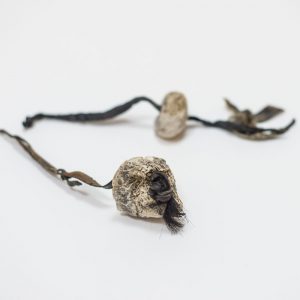 recommends as well as some mushroom extracts is Restor Medicine. Julie Daniluk, the popular anti-inflammatory nutritionist has some recommendations on supplements for Lyme Support on her website.
recommends as well as some mushroom extracts is Restor Medicine. Julie Daniluk, the popular anti-inflammatory nutritionist has some recommendations on supplements for Lyme Support on her website.
We’ll be taking Sacred Gardener’s Astragalus tincture along with our regular Chaga and Turkey Tail. I also keep a brew of Immune Boosting Tea on the slow cooker with the addition of Birch polypore. We will also be starting a dedicated garden for the herbs mentioned above.
UPDATE: I currently take a mushroom tincture combination of Chaga, Artists Conk, Maitake and Birch polypore, and a herbal tincture of Astragalus, Artemesia, Cleavers, Dandelion, Knotweed, and Teasel.
